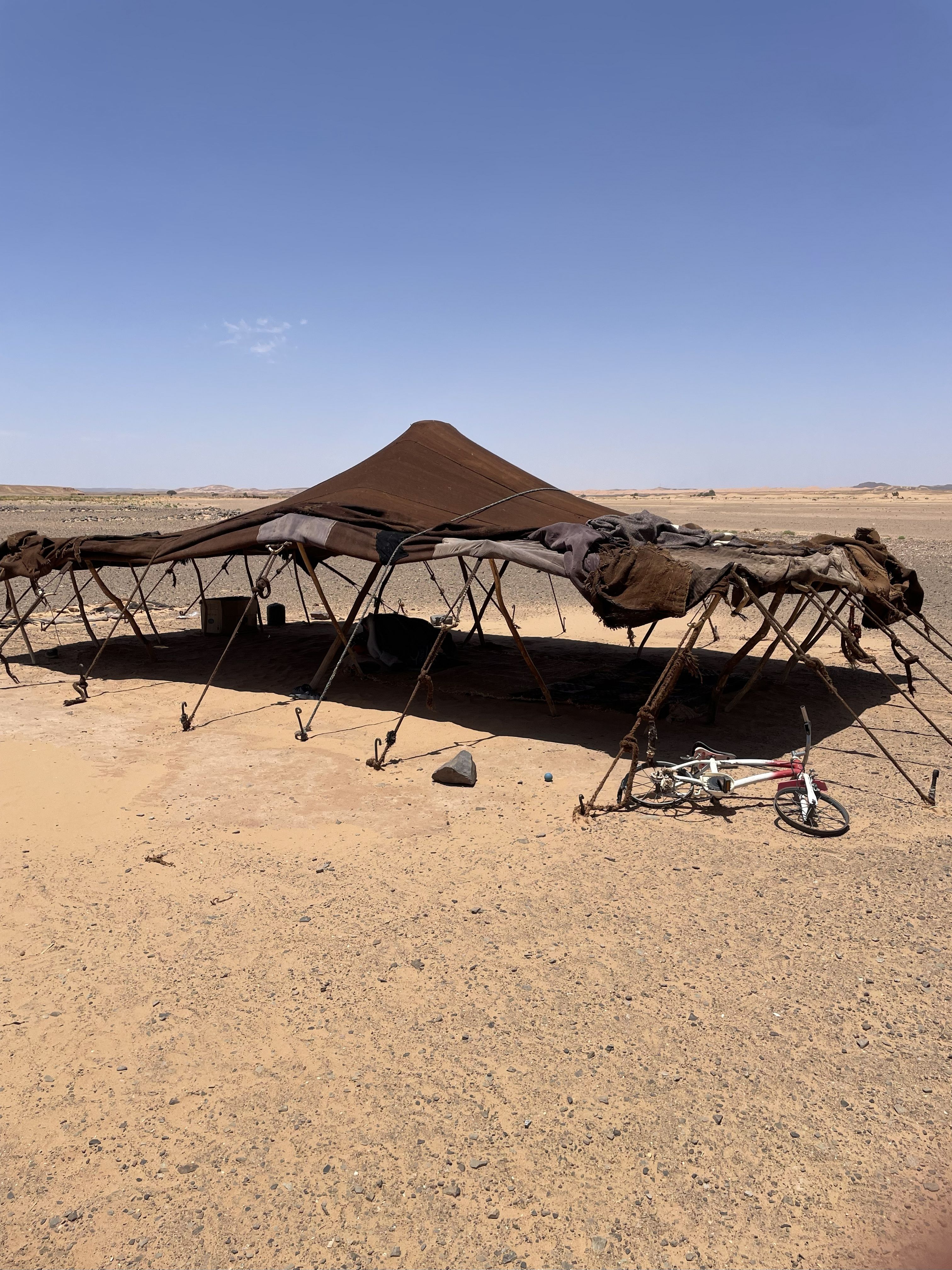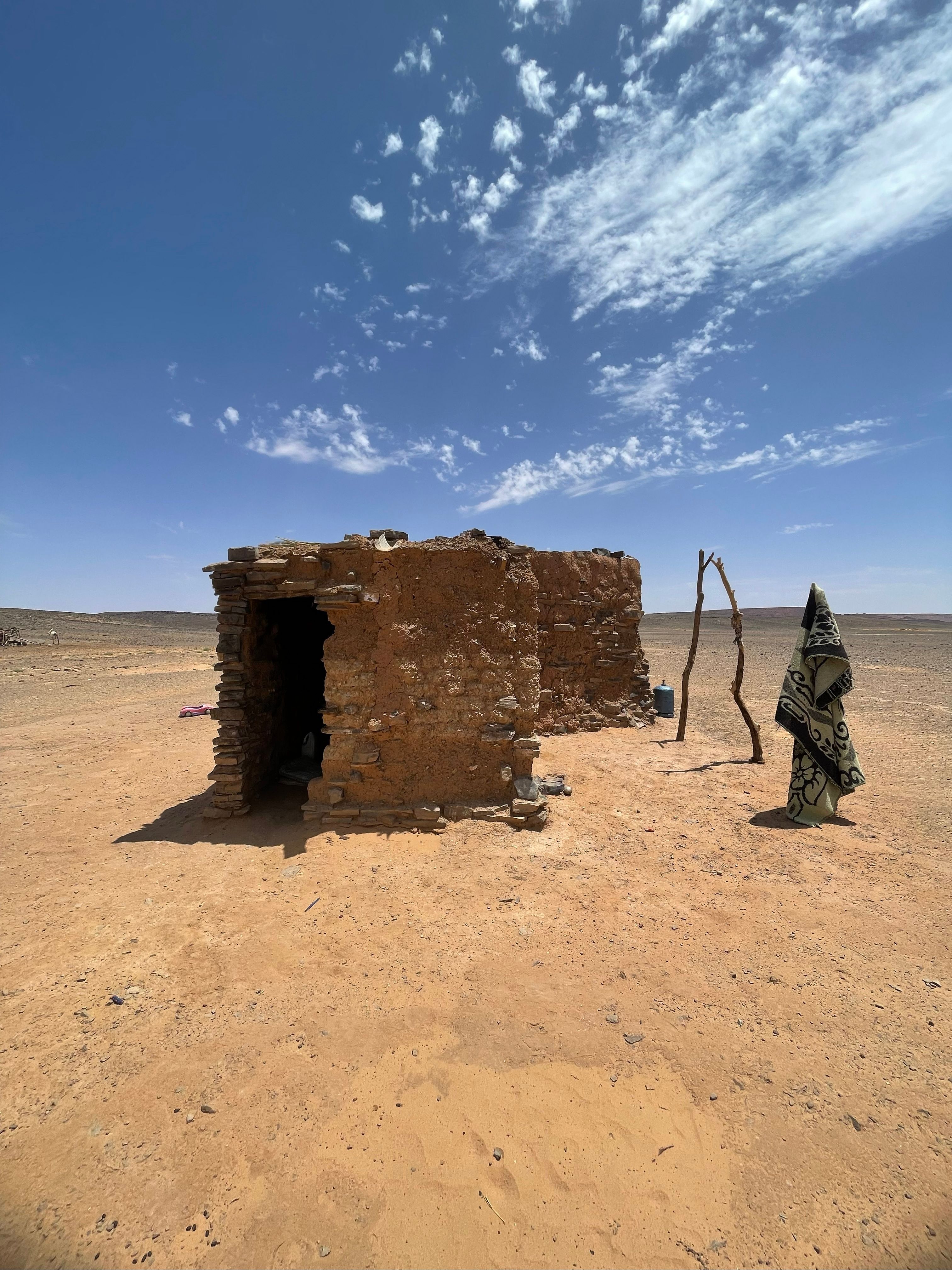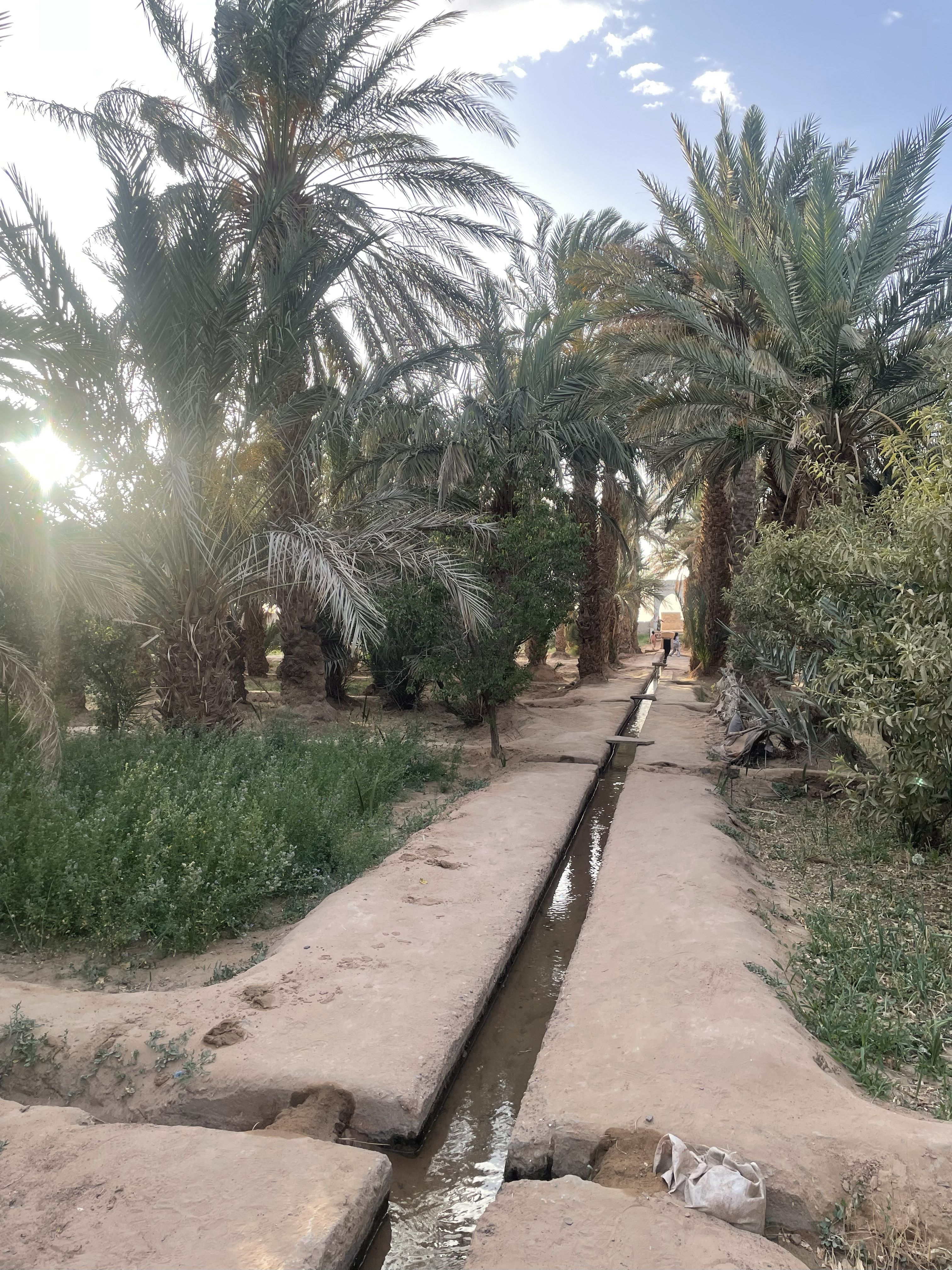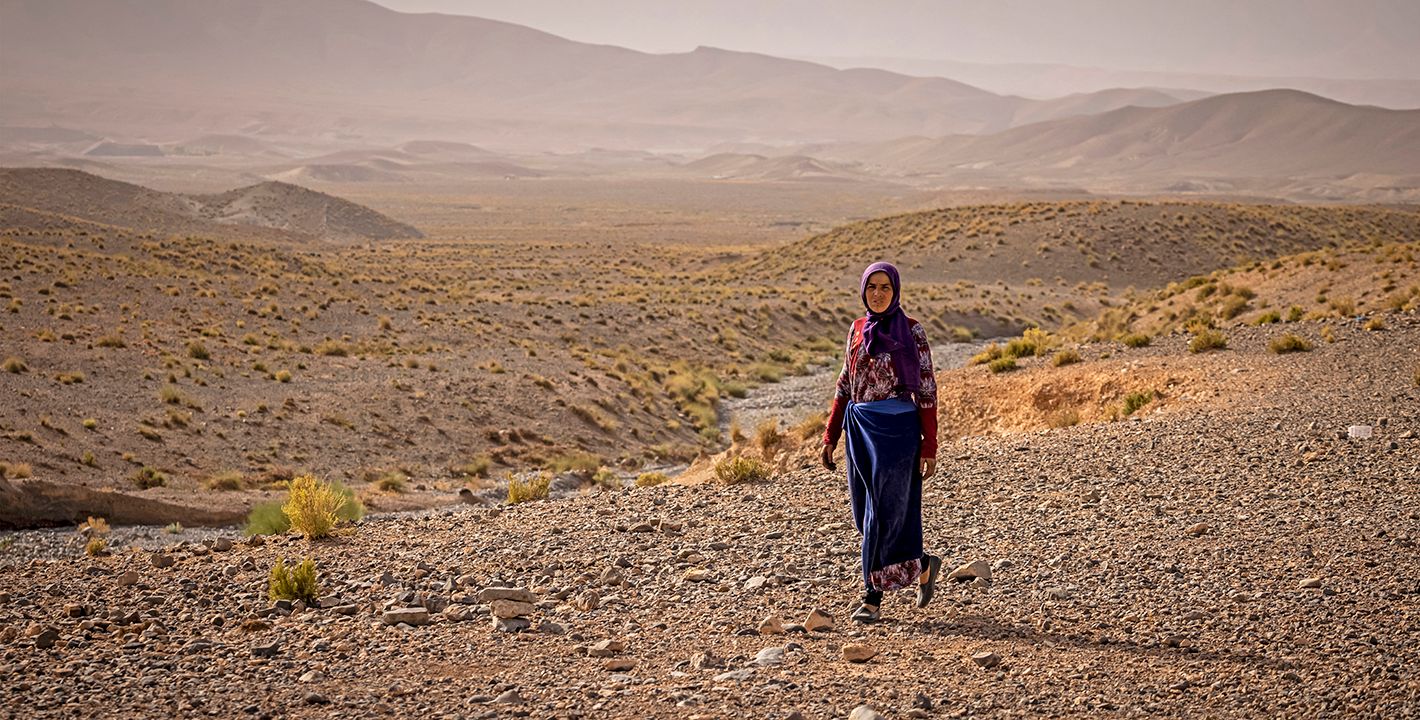Introduction
As climate change intensifies, its impact is felt most acutely by the world’s marginalized communities, where drought, irregular rainfall, and ecological degradation intersect long histories of political and economic neglect. This is very much the case in the desert regions of North Africa inhabited by indigenous communities. For the Ait Khabbash, traditionally nomadic Amazigh pastoralists in Morocco’s Draa-Tafilalet region, environmental change exacerbates long-standing inequities rather than simply creating new challenges. Their experiences illuminate a fundamental tension: while Morocco is lauded internationally as a climate leader, particularly for its renewable energy investments, its policies have been less effective in addressing the vulnerabilities of communities most exposed to climate change.
One way the Ait Khabbash have responded to challenges has been by migration. Over the past several decades, the Ait Khabbash have transitioned from nomadic livelihoods along the Morocco–Algeria border to sedentary settlement in villages such as Merzouga and Hassilibied, relocation to the urban centers of Ouarzazate and Marrakesh, and international migration to France and Spain.

A traditional tent, woven from camel and goat hair. Traditionally made by women, such tents can take twelve months to complete.

A small house on the outskirts of Hassilabied. Some families reside in both a tent and a house, alternating between the two.
More recently, the community has turned to building a tourism industry in its region from the ground up. On the one hand, this exemplifies how indigenous groups adapt to structural exclusion and ecological stress. Yet, on the other, the Ait Khabbash’s experiences lay bare the blind spots of state-centered climate policy frameworks—which often overlook indigenous knowledge and non-state adaptation. While grassroots adaptation strategies underscore the resilience of this marginalized community, initiatives developed outside the framework of state support remain highly vulnerable to economic shocks. Many desert tourism enterprises operate on a cash basis, without formal registration, rendering them ineligible for state support packages during crises, such as the COVID-19 pandemic.
As climate-related impacts intensify, these businesses may face comparable disruptions, further exposing the precarity of informal adaptation strategies. Consequently, community members’ lives are marred by entrenched inequalities and uncertainty for the future. To tackle climate-related challenges, improve state-society relations, and arrive at solutions that place the Ait Khabbash at their center, what is needed are strategies focused on trust-building, participatory mechanisms, sustainable practices, and cultural preservation.
The Ait Khabbash: Intersecting Vulnerabilities
The Ait Khabbash are a segment of the Ait Atta tribe, which is part of the wider Amazigh ethnic group. They have historically lived in the harsh desert climate and unforgiving landscape of southeastern Morocco and west-central Algeria, specifically the area surrounding the Tafilalet oasis. Here, in a place where water is life—aman iman, in Tamazight—the annual level of rainfall ranges from a few inches to less than an inch. For centuries, the Ait Khabbash have used a system that blends ecological knowledge with community cooperation to utilize and conserve water. They would also migrate seasonally in search of grazing land for their livestock. Over the past two hundred years, however, the community’s mobility has been increasingly constrained, and in recent decades their access to water has diminished.
Restrictions on mobility began with France’s occupation of Algeria in 1830. The French denied the Ait Khabbash access to some of their winter pastures and also periodically prevented them from engaging in the caravan trade. Restrictions on Ait Khabbash mobility continued after Morocco and Algeria gained independence from France—in 1956 and 1962, respectively—largely due to recurrent tension between the two countries. Repeated border closures and militarization curtailed access to pastures, driving people to sedentarization. Successive droughts in the 1970s, 1980s, and 1990s accelerated this process; many families gave up nomadism and settled in the towns of Rissani and Erfoud, as well as the larger cities of Ouarzazate and Marrakesh. These migrants sought work in construction, mining, or the military. Today, only a small percentage of Ait Khabbash families remains fully nomadic.
And then there is the matter of water scarcity. Already an arid environment, Draa-Tafilalet is experiencing reduced precipitation, intensified droughts, and heightened water scarcity. (Drought has contributed to the death of an estimated two-thirds of Morocco’s 14 million date palms over the past century.) Between 1970 and 2020, most regions in Morocco experienced a precipitation decrease of 4–5 percent per decade. In regions where the average annual rainfall is less than 80 millimeters, evapotranspiration—the transfer process of water from land to the atmosphere via evaporation and plant transportation—is one of the most important factors of water depletion. In interviews,1 members of the Ait Khabbash community noted that while the area has always been arid and subject to a harsh climate, periods of drought are now noticeably longer and more severe. Water is also scarcer: In interviews with the author, Ahmad,2 a nomad who runs a small, off-grid desert inn, mentioned that whereas they used to find water 8 meters below ground, now some people are having to dig as deep as 120 meters.
Environmental challenges in Morocco cannot be fully understood without considering governance—whether related to water privatization, the enforcement of environmental laws, or the continued marginalization of local voices and territories. For example, state-sponsored irrigation schemes centered on large dams that favor large-scale industrial agriculture serve to exacerbate climate-induced droughts. The Hassan Addakhil dam, constructed upstream of the Tafilalet Oasis on the Ziz River around Errashidia in 1971, and the Mansour Eddahbi dam, constructed in 1972, illustrate as much. Although intended to increase water reserves and control extreme flooding, these two dams have had a negative ecological impact, disrupting the feeding of downstream water tables and reducing soil fertilization. Coupled with over-extraction by motorized pumps, the building of large dams has led to reduced water for irrigation and the decline of oases ecosystems, which in turn has caused the desertification of land.

A motorized pump that uses solar power to generate electricity. With more people opting for solar panels, such pumps can be found across Morocco.
As a result of all this, pastoralism, once the core of the Ait Khabbash’s identity and economy, is increasingly unsustainable as a livelihood. Shrinking pastures and recurrent droughts push families to sell livestock, migrate, and sometimes abandon nomadism altogether. The lack of infrastructure such as schools or hospitals in remote areas has contributed to people’s decision to settle permanently in urban centers. At the same time, education, migration, tourism, and especially social media have exposed the Ait Khabbash to urban lifestyles, shaping aspirations among the youth. Whereas elders recall an existence much of which revolved around seeking freedom and the well-being of their livestock, younger generations are increasingly drawn to mobility, financial stability, and material possessions.
Migration from the Draa-Tafilalet to Europe started in the 1960s, with French agents recruiting workers for coal mines. Migration has predominantly been to France and, to a lesser extent, the Netherlands and Belgium. Remittances from the diaspora, along with mutual aid within the community, have been crucial in shaping the transition of the Ait Khabbash from nomadism to sedentarism and facilitating their coping strategies. The community’s networks stretch across Morocco, with strong concentrations in the southeastern cities and Marrakesh. Migrants often follow established Ait Khabbash routes, taking jobs within their networks’ businesses in Marrakesh, Ouarzazate, and Rissani.
Today, international migration is limited, as border securitization and perilous journeys across the Mediterranean make it increasingly difficult to reach European shores. Yet internal migration, directed to the big cities along the Atlantic coast or within the region (Marrakesh, for example) remains important. The development of villages into small and medium-sized urban centers has opened pathways to non-agricultural employment. Additionally, closer to home, many households have reoriented their coping strategies. This has translated into their building a resourceful and locally driven tourism industry spanning desert camps and guesthouses, as well as tourist guiding and transport services.
Grassroots Economic Development in Draa-Tafilalet
In recent years, members of the Ait Khabbash have constructed a tourism sector from the ground up, one centered on desert camps. The latter are seasonal encampments of tents, set up near sand dunes, that offer treks, meals, and overnight stays. They are distinct from the area’s guesthouses and small hotels, which are mostly permanent buildings, oftentimes located farther away from the sand dunes. Both types of facilities are built by local families and networks, which rely on community aid and remittances whenever possible; little state planning or investment is involved. The result is a thriving industry in a region that, previously, was seldom visited by international tourists.
These initiatives have provided thousands of jobs for members of the community, kept families together, and enabled them to remain closely tied to their ancestral lands. Indeed, whereas migration often disrupts intergenerational knowledge transmission, alters social structures, and produces feelings of cultural loss, homegrown economic projects facilitate cultural continuity and maintain a form of communal cohesion. Nevertheless, the desert camps, which are water-intensive, remain vulnerable to climate change and global shocks.
The first municipal hostel was set up in Merzouga in 1975. In the early years, local families offered tea, camel treks, and simple bivouac tents in the dunes to the few tourists visiting the region. International tourism in Draa-Tafilalet took off in the late 1980s. By the early 2000s, spurred by new infrastructural developments such as electricity, drinking water, internet networks, and roads linking Rissani to smaller towns, it had become a multi-million dollar industry. Alongside dune excursions, a “sandbath” practice (psammotherapy, or defna in Moroccan Arabic), touted for its health benefits, also grew in Hassilabied and Merzouga, drawing visitors largely from northern Morocco. Driven mostly by nomadic families who set up the first local tourist agencies, as well as migrants who returned home, the sector expanded from modest tents into a mix of larger camps, luxury bivouacs, and guesthouses. Despite the 2006 Merzouga floods, which caused significant damages to the infrastructure, locals rebuilt quickly.
Most touristic activities are located around Ouarzazate, as well as in Merzouga and Hassilabied. Restaurants as well as businesses renting out motorcycles and sports utility vehicles for off-roading are also to be found. Foreign tourists make up most visitors to the camps and hotels: in 2018, two-thirds of arrivals in the country visited Ouarzazate, with 23 percent going to Errashidia Province. In 2025, the first edition of Draa-Tafilalet Days, a festival meant to showcase the region’s tourism capacity, took place.
The transition from nomadism to tourism usually relies on one person of a household, the elder son for example, moving to a nearby town with camels or working in a hotel before being joined by remaining family members. Hassan began life as a nomad in Rifai, moving between Tafraout, Mharesh, and back home during the winter months. In 2004, when he was in his early twenties and his siblings were old enough to look after the family’s camels, Hassan moved to Hassilabied in search of employment. His relocation was enabled by an uncle, who helped him find work rehabilitating palm groves. Later, another relative helped him secure a job as a camel-driver for tourists at a hotel in the town. Over time, his brothers joined him in order to establish a temporary desert camp in the area. As bookings multiplied, and the desert camp tourism industry in general grew, they sold their remaining camel stock to build a permanent site, and before long the rest of the family joined them.3
In the same vein, women have carved out a space for themselves in the tourism sector, albeit a smaller one. Oftentimes, they do this through cooperatives, which are jointly owned organizations through which members pool resources and share profits. In Hassilabied, for example, a women’s cooperative operates to produce traditional biscuits and sweets to supply several desert camps.4 Such cooperatives help women secure livelihoods by converting household skills into market and capital access. This enables them to collectively coordinate labor, maintain the social bonds that underpin community, and integrate women into the tourism industry.
Although tourism offers the Ait Khabbash community an avenue of livelihood diversification, the sector is intricately tied to climate change, and thus remains vulnerable. Indeed, with camps often requiring water for facilities such as swimming pools, desert tourism is dependent on a scarce resource. Tourism is also susceptible to global shocks, as illustrated by its worldwide collapse during the COVID-19 pandemic. Many Ait Khabbash community members who had transitioned to tourism were left jobless overnight, some returning temporarily to nomadism or agriculture.
Ultimately, while the Ait Khabbash’s turn toward carving out a tourist sector in the desert embodies resilience, it also carries costs. In interviews, many community members expressed sadness at the erosion of traditional nomadic life and lifestyles. Adaptation, even when it includes resilience, may involve cultural erosion or heightened vulnerability, raising critical questions about what constitutes success. Moreover, in this case, adaptation alone cannot offset the structural vulnerabilities produced by prolonged droughts, declining pastures, and irregular access to services. These dynamics of resilience-amid-precarity highlight the disjuncture between local strategies and national policy frameworks, an issue sharpened by the state’s uneven presence in Morocco’s desert.
The Ait Khabbash and the Moroccan State
Despite hosting flagship economic projects, the Draa-Tafilalet region suffers from inadequate infrastructure, poor services, and minimal state investment in social development. Local non-governmental organizations (NGOs) fill some critical gaps—for example, by restoring palm groves or drilling solar-powered wells—but these interventions remain piecemeal and limited in scale. Neither NGO projects nor the adaptation strategies pursued by members of the Ait Khabbash (whether individually or collectively) suffice to compensate for the compounded impact of climate change and socioeconomic exclusion.
Draa-Tafilalet embodies the paradoxes of Morocco’s developmental trajectory. Despite being resource-rich, with extensive silver and mineral deposits, and even though it hosts the Noor solar plant, one of the world’s largest concentrated solar facilities, the region remains one of Morocco’s poorest. It contributes less than 1 percent of national gross domestic product, while its poverty rate (14.6 percent) and vulnerability index (16.2 percent) exceed national averages. According to the Haut-Commissariat au Plan’s poverty map, in 2024 Draa-Tafilalet recorded a poverty rate of 7.7 percent—higher than the national average of 6.8 percent. In fact, the combined incidence of poverty and vulnerability reached its highest rate nationally in the region, at 19.5 percent.
This is due to a combination of factors, including low levels of schooling, limited access to healthcare, and difficult living conditions marked by poor access to basic services and infrastructure (water, electricity, communication, sanitation, and housing). These socioeconomic pressures converge with a rapidly deteriorating ecological base, amplifying the fragility of traditional livelihoods. Addressing such structural pressures entails a negotiated state-society compact that is calibrated to the region’s needs. For the state, such engagement would mitigate rural-urban displacement, preserve landscapes and tourism assets, and reduce the costs associated with recurrent climate shocks. For local communities, it would anchor adaptation strategies in more predictable and long-term support.
Widespread community disengagement from the state, with a legacy of historical neglect and memories of authoritarian repression, has fostered autonomy but hindered integration. For example, some desert camps are unregistered, and therefore ineligible to receive state assistance in times of hardship. Many Ait Khabbash prefer self-reliance through community networks, as opposed to engagement with state programs. Indeed, the majority of Ait Khabbash do not make use of the banking system; even though government grants are available for tourism projects, most members of the community choose not to take them. In an interview, Omar, an owner of a desert camp, said, “We would rather borrow money from someone in the community [than accept a government grant].”5 Recognizing these dynamics raises critical questions: how can climate governance frameworks integrate marginalized voices, respect indigenous practices, and overcome legacies of distrust?
First, trust-building through participatory decisionmaking is vital to bridging the gap between local adaptation and national economic frameworks. Ideally, this would take the form of community-led climate councils and decentralization—thereby ensuring the transparent allocation, distribution, and use of resources at the local level. In 2015, Morocco announced plans for régionalisation avancée, or advanced regionalization, a process of decentralization that would involve transferring power, responsibilities, and resources away from the central government and toward local authorities. While its implementation has so far been challenging and sporadic, decentralization still has the potential to encourage the development of integrated policies that attend to the specificities of each region.
For participatory mechanisms to be accessible to local communities in practice, they must be accompanied by concerted efforts to produce and transmit politics in local languages. In Draa-Tafilalet, the introduction of Tamazight would support communities’ engagement in designing and implementing policies that align with their needs. Civil society, NGOs, and research networks can play a key role in facilitating this process. Focusing on access through local languages is a necessary step to shift participation from an ephemeral box-ticking exercise into co-production, whereby communities are able to shape policy.
Secondly, it is imperative to bolster the sector’s resilience to shocks caused by natural disasters and crises and provide social protection mechanisms for workers. One way to help achieve both these objectives is through building capacity for domestic tourism, which would reduce reliance on international tourists. This entails diversifying services and products (through cultural programming and multi-day circuits, for example), as well as strengthening existing infrastructure such as waste management, road access, and off-grid power. Upgrading what is on offer would provide a stable base to build on what the community has achieved. Importantly, however, these steps need to be integrated within national frameworks.
Relatedly, indigenous knowledge systems that embody centuries of adaptation to arid environments can complement modern practices and new technologies. This is particularly true for maintaining oases—which are both a key pillar for sustenance and an under-utilized tourism asset. The Ait Khabbash have historically made use of the khettara, an age-old cooperative practice whereby a series of tunnels tap into groundwater and channel it to the surface for irrigation.Unlike modern wells equipped with motorized pumps, the khettara cannot exhaust non-renewable fossil water from deep aquifers. For centuries, it enabled the Ait Khabbash to withstand water scarcity. The preservation of the khettara and other systems is vital for trust-building and livelihood diversification. National strategies should evaluate their scalability and integration into nationwide frameworks for the preservation of the environment.

In the khettara system—which has seen a revival in Hassilabied since the early 2000s, thanks to cooperation between local NGOs and the United Nations Development Programme—land is divided between members of the community, who often grow vegetables and date palms.
Together, these elements can strengthen state-society relations, sustain traditional livelihoods, and ensure that costs and benefits are borne fairly and equitably across communities. For climate governance to be just and durable, it must rest on trust-building, participatory mechanisms, and the integration of indigenous knowledge into policy frameworks. Supporting grassroots initiatives, protecting cultural heritage, and ensuring equitable access to resources is not only a matter of social justice. It is also a practical necessity for sustainable adaptation in arid regions.
Conclusion
As climate impacts intensify, relying solely on grassroots resilience without structural support would deepen existing inequalities and expose informal sectors to repeated shocks. At the same time, however, the Ait Khabbash case points to the urgent need for climate policies beyond centralized, top-down methods. Marginalized communities must be meaningfully engaged with and integrated as partners in adaptation frameworks. National strategies should invest in participatory governance mechanisms, strengthen social protection systems, and integrate indigenous knowledge into climate planning. Building trust through inclusive decisionmaking, improving infrastructure, and supporting locally driven economic initiatives can transform adaptation from a reactive, fragmented process into a proactive, equitable framework—one that safeguards both livelihoods and cultural heritage while advancing national climate goals.
This work is licensed under a Creative Commons Attribution 4.0 International License. For more details regarding the license deed, please visit: CC BY 4.0 Deed | Attribution 4.0 International | Creative Commons.
Notes
1Interviews conducted between May and June 2025.
2Names have been changed.
3Author interview, conducted in Draa-Tafilalet in June 2025.
4Author interview, conducted in Draa-Tafilalet in June 2025.
5Author interview, conducted in Draa Tafilalet in June 2025.




